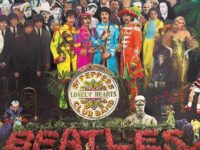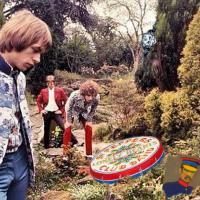John Lennon and Paul McCartney could write from different perspectives — a young woman in “She’s Leaving Home,” or a randy young man in “Lovely Rita” — but “Getting Better” may be one of the most personal tracks the duo ever recorded. A tale of optimism, humility, and a touch of what author Gary Tillery calls “cynical idealism,” “Getting Better” narrates how one man tries to learn from past mistakes and reinvent himself. In 1980, Lennon called the lyrics a “diary form of writing,” and the track allows the duo to reveal their own transformations from their Liverpool days to their London present.
According to Hunter Davies’ Beatles biography, the idea for “Getting Better” came from an unlikely source: Jimmie Nicol, the drummer who subbed for an ailing Ringo Starr during the Beatles’ 1964 tour of Europe, Hong Kong, and Australia. While on that tour, the group would frequently ask Nicol how he was holding up under the pressure. “It’s getting better,” Nicol replied.
That phrase randomly popped into McCartney’s head while he walked his dog Martha one day in March 1967. After returning to his St. John’s Wood home, McCartney began composing a tune on his “magic Binder, Edwards and Vaughan piano,” as he told biographer Barry Miles. At this time, Lennon and McCartney were collaborating on songs for Sgt. Pepper’s Lonely Hearts Club Band, and would work in McCartney’s music room. When Lennon arrived for their daily writing session, McCartney had already fleshed out the music for the song.
Next came the lyrics, and Lennon and McCartney drew upon personal experience for the words. McCartney wanted to create an overall positive track, although he and Lennon manage to insert a dig at their past teachers. “The ‘angry young man’ and all that was John and I filling in the verses about schoolteachers,” McCartney told Miles in Many Years from Now. “We shared a lot of feelings against teachers who had punished you too much or who hadn’t understood you, or who had just been bastards generally. So, there are references to them.”
In one of his final interviews, John Lennon added that the section on the narrator treating his woman better derives from his own life. “All that ‘I used to be cruel to my woman, I beat her and kept her apart from the things that she loved’ was me,” Lennon said. “I used to be cruel to my woman, and physically … any woman. I was a hitter. I couldn’t express myself and I hit.” He described his evolution, explaining “I am a violent man who has learned not to be violent and regrets his violence. I will have to be a lot older before I can face in public how I treated women as a youngster.”
One myth persists about the “it’s getting better all the time / it couldn’t get no worse” lines. Legend had it that as Paul McCartney rehearsed the track at Abbey Road Studios, Lennon suddenly blurted the “it couldn’t get no worse” phrase. In fact, the duo contrived the call-and-response section during their writing session. As McCartney crooned “It’s getting better all the time,” Lennon sang his sarcasm-dripped response. “And I thought, ‘oh, brilliant!’ This is exactly why I love writing with John,” McCartney told Miles. “He’d done it on a number of other occasions, he does a Greek chorus thing on ‘She’s Leaving Home,’ he just answers. It was one of the ways we’d write. I’d have the song quite mapped out and he’d come in with a counter-melody.”
The Beatles began recording the track on March 9, completing seven takes of the rhythm track. McCartney played rhythm guitar and piano; George Harrison contributed lead guitar; and Ringo Starr, as usual, manned the drums and congas. According to Mark Lewisohn’s Complete Beatles Recording Sessions, another musician contributed to this session: producer George Martin, who also played piano by striking the strings directly. The group returned to “Getting Better” the next day, finishing various overdubs: Harrison played tambura, while McCartney added his bass part.
All seemed on track until March 21, when the Beatles were to lay down their vocals. In Anthology, Martin recalled that as Harrison and McCartney were overdubbing their vocals, Lennon suddenly complained that he was feeling ill. Thinking he needed fresh air, Martin escorted him to the Abbey Road Studio roof, not realizing that the Beatle had in fact ingested LSD. As they stood on the roof, Lennon moved to the very edge and gazed up at the stars. Martin left Lennon alone, returning to the studio.
When the others asked where Lennon was, the producer innocently replied that he was standing on the roof. Knowing that Lennon was under the influence of LSD, Harrison and McCartney fled to rescue their friend “He had been left alone on the roof of studio two which has no rails or barriers, just a sheer drop of about 30 feet to the ground below,” Lewisohn writes.
In his 1970 Rolling Stone interview, John Lennon recalled Martin expressing alarm at his behavior; at that point, the Beatle realized that he had taken LSD rather than uppers, as he had thought. Due to his condition, Lennon had to sit out the rest of the session. Luckily, he recovered enough to finish laying down vocals on March 23.
“Getting Better” is about a changed worldview, a story of love transforming the narrator’s life. Staccato guitar notes and George Martin’s striking of the piano strings break through the silence, startling listeners and demand that they listen. After the Beatles harmonize on the phrase “it’s getting better all the time,” booming bass, Starr’s steady drums, and keyboards enter the picture.
The first lyrics describe negative experiences at school, with Paul McCartney complaining of teachers “holding me down / turning me ‘round / filling me up with your rules.” Interestingly, John Lennon expresses some optimism at the beginning, responding in falsetto with “no I can’t complain” when McCartney sings “I used to get mad at my school.” Then comes the familiar refrain, with the narrator expressing joy at his changed worldview (“It’s getting better / A little better all the time”); Lennon injects his brand of cynical idealism by adding “it can’t get no worse.”
Is he cautioning McCartney not to let his rosy outlook falsely distort reality? Undeterred, McCartney announces that since his girlfriend entered his life, he has been inspired to revise his previous beliefs. As he enthusiastically informs us, “since you’ve been mine” optimism has ruled his life. Note how his delivery of this line slightly echoes his voice on “Got to Get You into My Life.”
The next stanza recalls how he was an “angry young man” and hiding his “head in the sand,” apparently unwilling to face his flaws. His lover has encouraged him to change, and he has decided to follow her advice. “I’m doing the best that I can,” McCartney sings, admitting that his journey has not always been smooth. Perhaps this statement counters Lennon’s pessimism; in other words, trying to improve oneself bests remaining stagnant. Harrison, Lennon, and McCartney harmonize on “better all the time,” as if urging the narrator to continue his quest. They repeat “better” three time, one voice changing to three by the final “better.” They form a cheering section for listeners as well as the lead character, persuading everyone to break old habits.
Then comes the most intriguing section of the song, the decidedly darker bridge (introduced by George Harrison’s foreboding droning tambura): “I used to be cruel to my woman / I beat her and kept her apart from the things that she loved,” Lennon and McCartney harmonize. As Lennon stated in the 1980 Playboy interview, this section was largely autobiographical, echoing his own transformation and regret at past behavior. The protagonist admits to “changing my scene,” reiterating the narrator is “doing the best that I can.”
This section proves jarring, as it frankly describes abhorrent behavior but expresses willingness to change. Few artists would have the courage to address such an issue in 1967, but the Beatles once again demonstrate their eagerness to defy convention, even adding the tambura to enhance this section’s serious tone.
As the three repeat “getting so much better all the time,” the song ends as it began: guitar notes and piano strings take over as the other instrumentation drops out. The brash notes symbolize the protagonist’s determination and progress on his journey, and the fadeout suggests that he is embarking on a lifelong quest.
Through music and words, the Beatles tell a personal story of redemption, but emphasize that the narrator will probably falter. Lennon’s sardonic delivery of certain lines represent skepticism, but ultimately the narrator’s persistence takes over. The “warts and all” story of “Getting Better” illustrates Lennon and McCartney’s collaborative style, differing outlooks, and willingness to reveal personal truths.
- The Rescued Early Paul McCartney Song That Completed ‘Beatles For Sale’ - December 4, 2024
- A Rare Beatles Cover Proves John Lennon Was Wrong About His Voice - November 26, 2024
- How John Lennon Came Roaring Back on the Beatles’ White Album - November 22, 2023





For quite a long time (decades), I couldn’t understand what Lennon was singing when he said “It couldn’t get no worse.” However, after I realized what he sang, I never understood it as cynical. Rather, to me, it displays his masterful use of English to express something in an unconventional way (like the studio chat available on YouTube in which he notes having a problem hitting a note by saying, “It could be there, or it couldn’t). In fine, if “it’s getting better all the time,” then truly “it couldn’t get no worse.”
Interesting interpretation! Thanks for commenting (and sorry I didn’t see this until now).